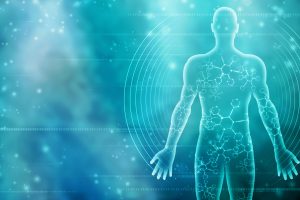Biomarkers are a measurable indicator of a biological condition.
They can be used for diagnostics (identifying a disease or condition), prognostics (predicting disease course/severity) or therapeutic monitoring (identifying if a therapy is working/will work). Biomarkers may also be used during drug development to show that a drug is hitting its target, and to aid in dose selection.
Ideally biomarkers should be safe and easy to measure, cost efficient, changeable with treatment and consistent across gender and ethnic groups.
Biomarkers in DMD
A commonly used diagnostic biomarker for DMD is serum creatine kinase (CK). CK is a muscle enzyme that leaks into the bloodstream upon muscle damage, so elevated CK in the blood is a marker for muscle damage. CK is not specific for DMD or even muscular dystrophy, since it is elevated in blood even in healthy people after muscle damage due to injury or heavy exercise. In clinical practice when patients present with muscle weakness, it can have several causes and detecting elevated CK levels points to a problem in the muscle rather than in the nervous system.
There are currently no prognostic or therapeutic monitoring biomarkers available for DMD, but identifying novel biomarkers in DMD is an important part of ongoing research.
Biomarkers in clinical trials
There are several ways biomarkers can be used to help new drug development in a clinical trial. Predictive biomarkers can be used to identify patients who will respond to the intended treatment before starting the trial. Biomarkers can also be used to assess whether patients are responding to treatment during the trial. With this information, those patients most likely to respond can be recruited or continue to be in the clinical trial. Optimizing which patients enter and remain in a trial is expected to make it easier to detect clinical benefit.
Biomarkers can also be used to show if a treatment worked as expected. This can be done with pharmacodynamic (PD) biomarkers, which are markers that change upon treatment. A specific subset of pharmacodynamic biomarkers can be used to confirm the drug mechanism e.g. increased dystrophin levels in the muscles of DMD patients is expected to be a pharmacodynamic biomarker for therapeutic approaches aiming to restore dystrophin expression, while reduced fibrosis could be a pharmacodynamic biomarker for antioxidants or other anti-fibrotics. In VISION-DMD, PD biomarkers are being used to assess aspects of safety and efficacy of vamorolone.
Some biomarkers can be used as surrogate endpoints, meaning they can be used instead of a functional outcome measure. For a biomarker to be accepted as a surrogate endpoint, appropriate data must show that the biomarker correlates with current or future clinical benefit. Surrogate endpoints can predict a response to therapy and are tools that can be used to accelerate the process of making a drug available on the market. They show less variation than functional tests (like measuring muscle strength or walk distance, which can depend also on patient motivation) and they may also show quicker than functional tests whether the drug works or not.
In 2016, the US FDA approved Exondys 51® (eteplirsen) under an accelerated approval pathway, based upon the surrogate endpoint of dystrophin increase in skeletal muscle observed in some Exondys 51-treated patients.
Biomarkers in VISION-DMD
VISION-DMD aims to develop a panel of biomarkers of different cellular functions to better predict and monitor clinical outcomes. This approach will be readily transferable to future studies to monitor disease progression and response to therapies meeting a current need in DMD drug development programmes. Effective pharmacodynamic biomarkers can have impact at several levels:
- They may provide insights about current drug development including effectiveness, dosage and schedule optimisation;
- They could be used to detect early benefits, prior to physical/motor changes.
Procedures may be less invasive for DMD patients entering clinical trials and if successful could shorten the duration of clinical trials, reducing the trial cost and thereby more rapidly move the drug to market. Successful qualified biochemical biomarkers could potentially be transitioned to standard of care in DMD, to monitor patients in the clinic and offer more timely and effective clinical management.
VISION-DMD Safety Biomarkers
There are well-established safety biomarkers established to identify the specific side effects of prednisone use and these will be used as safety biomarkers in vamorolone clinical studies. The VISION-DMD clinical trials programme will investigate biomarkers for:
- Adrenal suppression. Prednisone treatment leads to rapid decrease of serum cortisol levels reflecting adrenal suppression. Adrenal insufficiency as a pathological state is given as a ‘diagnosis’ when the adrenal glands cannot respond after cessation of glucocorticoid treatment (persistent loss of cortisol from adrenals);
- Insulin resistance. Prednisone causes both acute and chronic insulin resistance. Prednisone-induced insulin resistance includes decreased release of glucose by liver, and impaired glucose uptake from blood by target organs (muscle). Prednisone-induced insulin resistance in DMD may exacerbate myofiber defects in both anaerobic and aerobic metabolism;
- Bone turnover. Prednisone-induced bone fragility is a serious safety concern. Increased osteocalcin is an established biomarker of prednisone-induced bone turnover.
VISION-DMD Exploratory pharmacodynamic biomarkers
VISION-DMD will utilise a pre-specified panel of exploratory serum biomarkers to explore the effect of vamorolone on inflammation and safety concerns associated with traditional steroidal drugs.
Exploratory safety biomarkers
- Angiotensinogen may be marker for renin-angiotensin-aldosterone axis
- Growth hormone binding proteins (GHBP; growth hormone extracellular inhibitor) may be a marker for growth suppression
- Afamin, leptin may be markers for metabolic disturbances
Exploratory efficacy biomarkers
- Pro-inflammatory proteins suppressed by prednisone (e.g., macrophage derived chemokine, MMP-12, CD23)
- Anti-inflammatory proteins increased by prednisone (e.g., protein C)
The CINRG group carried out a systematic discovery study of prednisone treated boys with DMD, and identified candidate glucocorticoid-responsive proteins, most of which validated in children with inflammatory bowel disease (Hathout, et al., 2016).
In the first-in-human trials of vamorolone in healthy adult male volunteers treated for 2 weeks at doses up to 20 mg/kg (VBP15-001), there were no pharmacodynamic biomarker safety concerns of existing glucocorticoid drugs (Hoffman, et al., 2018).
A first-in-patient clinical trial of vamorolone in 48 boys with DMD (VBP15-002) pre-specified 7 of the glucocorticoid-responsive biomarkers shown as exploratory outcomes for anti-inflammatory mechanism of action. Six of the 7 efficacy biomarkers showed dose-responsive decreases with 2 weeks of vamorolone treatment in boys with DMD [CD23, MDC, IL-22BP, IGFBP-2, LTa1/b2, and MMP‑12], indicating an anti-inflammatory mechanism of action. There was also a beneficial effect on plasma membrane stability (as demonstrated by a dose-responsive decrease in serum creatine kinase activity (Conklin, et al., 2018).
More information on biomarkers in DMD, and PD biomarkers used in vamorolone trials:
Large-scale serum protein biomarker discovery in Duchenne muscular dystrophy
Glucocorticoid-responsive biomarkers in children with DMD and inflammatory bowel disease
VISION-DMD Biomarker workshop
A number of international meetings have discussed the need for progress on biomarker development for DMD, especially biomarkers for clinical trials that can be used as surrogate endpoints. VISION-DMD in collaboration with the European Reference Network for Neuromuscular Diseases – EURO-NMD, organised a workshop to review and update the current thinking around biomarkers and imaging for DMD, aiming to identify the challenges in biomarker method validation for DMD and develop a strategic roadmap for biomarker qualification.
To find out more about the workshop click here
